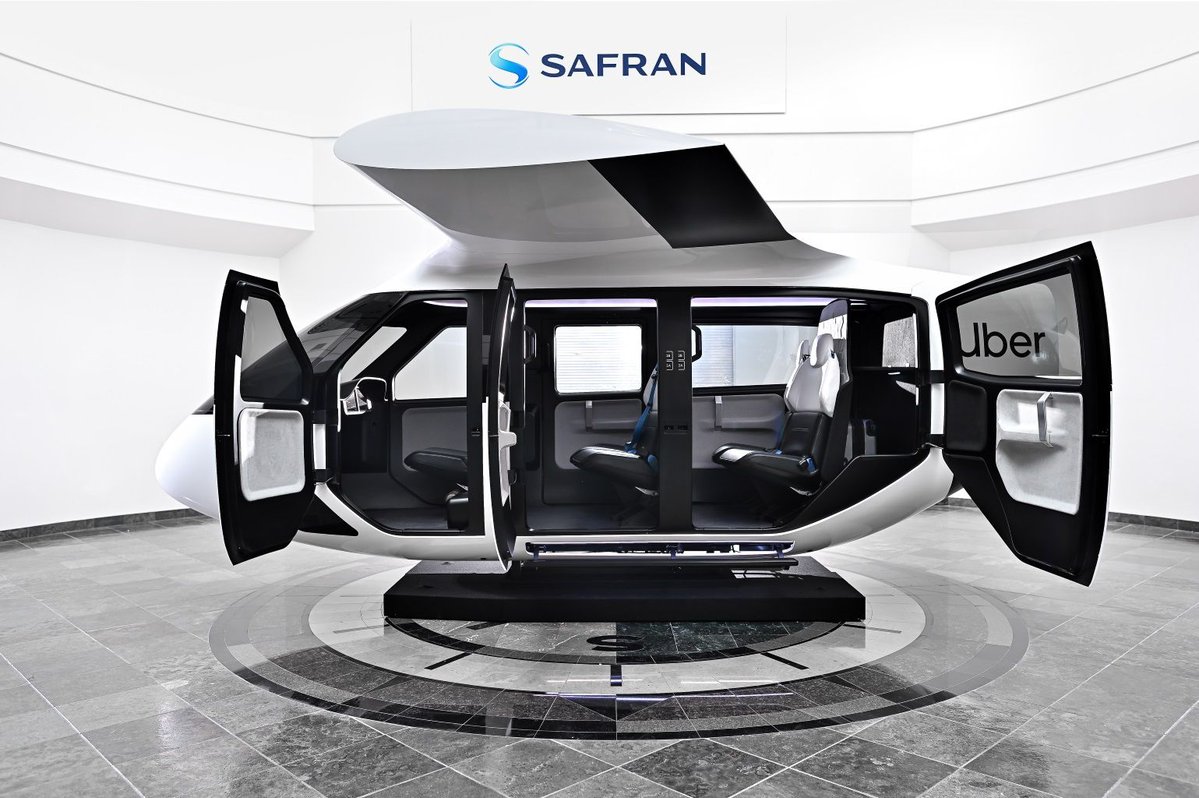
Safran’s cabin design for Uber’s UAM mission. Note the doors and wing, designed to work together to create an inviting experience to passengers. (Safran)
Safran designing cabins for Uber air taxis is a bit of an unusual arrangement because Uber Elevate is not in the business of manufacturing aircraft.
It does afford some opportunities, though, according to Scott Savian, executive vice president of Safran Cabin.
“An OEM will give you a specification,” he said. “Uber gave us a very high-level vehicle mission, said ‘Give us a cabin to support that.'”
What that means is rather than demanding door handles in a specific place, windows of a certain size or seats of a particular material, Uber wanted a good experience that would achieve its goals and left Safran free to decide the solution.
It’s similar to the approach the ride-share giant has taken with its vehicle manufacturing partners: Uber explains its mission — albeit with some pretty specific requirements and some preferences on how it thinks those requirements are best met — and lets manufacturers come to it with proposals. Then Uber chooses the ones it likes and can realistically meet its requirements.
Despite the fact that Uber will never be buying Safran’s cabins, Savian said the arrangement connects it with aircraft manufacturers who will eventually build air taxis positions its cabin designs to meet their needs.
To that end, Safran has developed a cabin with modularity in mind.
“If you want to take our door pane out and put in one with a cupholder and an iPad-holder, no problem,” Savian said.
Safran’s cabin was designed with a fairly generic air taxi platform in mind and can easily be customizable for any manufacturer’s needs.

Want more eVTOL and air taxi news? Sign up for our brand new e-letter, “The Skyport,” where every other week you’ll find the most important analysis and insider scoops from the urban air mobility world.
Savian said Safran was informed by a “deep dive” into passengers habits and preferences, how they get on and off vehicles and other data afforded by Uber.
“It’s not too many times you’re taking a trip lasting 7 to 15 minutes,” but that’s the model for urban air mobility, he said.
Safran designed coach-style doors that open away from the B pillar under the wing, which is intended to provide an open, inviting appearance, Savian said. The rear door portal extends far enough back that it provides access to the storage area without passengers needing to go around to a separate trunk.
“In many ways, the cabin is intended to be seamless,” Savian said. “We don’t want there to be pain points.”
Because these vehicles likely will fly at between 1,200 and 1,500 feet, a premium was put on windows. While movie screens might be exciting, they aren’t really practical on such short-hop flights, and the view of the ground is the real star, Savian said. Besides, riders will still be in data range at that altitude, so passengers can check email and stream content on their personal mobile devices while airborne.

The cabin feels roomy thanks to design choices like the seat angle. (Nick Zazulia/AVI)
The cabin feels roomy thanks to design choices like the seat angle. (Nick Zazulia/AVI)The seats are touching but angled away from each other to provide extra space, legroom and privacy, unlike on a commercial airliner where seat neighbors. The seats are modeled after traditional helicopter seats, just a bit taller.
Safran was tasked with straddling the line of luxury and efficiency. The cabin should look nice and be comfortable, but cost and size, weight and power (SWAP) were critical considerations. The interior lining of the doors and walls is simple rather than opulent, and the company didn’t opt for embellishments beyond overhead lights and examples of pilot displays in the cockpit.
“The efficiency drives a lot of the price point,” Savian said. “We’re looking for economy in weight and space, which drives cost too.”
That combination may make Safran’s basic cabin, with some custom adjustments, an attractive option to Uber partners. While the cabin was developed in conjunction with Uber, the French company has had conversations with third-party vehicle manufacturers. That’s another perk to working with the rideshare giant, Savian said: It can connect you with everybody.